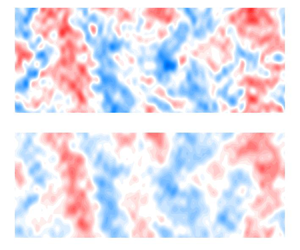Crossref Citations
This article has been cited by the following publications. This list is generated based on data provided by
Crossref.
Gupta, Vikrant
Madhusudanan, Anagha
Wan, Minping
Illingworth, Simon J.
and
Juniper, Matthew P.
2021.
Linear-model-based estimation in wall turbulence: improved stochastic forcing and eddy viscosity terms.
Journal of Fluid Mechanics,
Vol. 925,
Issue. ,
Kleine, Vitor G.
Sasaki, Kenzo
Cavalieri, André V. G.
Brès, Guillaume A.
and
Colonius, Tim
2021.
Real-time supersonic jet noise predictions from near-field sensors with a wavepacket model.
The Journal of the Acoustical Society of America,
Vol. 150,
Issue. 6,
p.
4297.
Wang, Mengying
Krishna, C. Vamsi
Luhar, Mitul
and
Hemati, Maziar S.
2021.
Model-based multi-sensor fusion for reconstructing wall-bounded turbulence.
Theoretical and Computational Fluid Dynamics,
Vol. 35,
Issue. 5,
p.
683.
Martini, Eduardo
Jung, Junoh
Cavalieri, André V.G.
Jordan, Peter
and
Towne, Aaron
2022.
Resolvent-based tools for optimal estimation and control via the Wiener–Hopf formalism.
Journal of Fluid Mechanics,
Vol. 937,
Issue. ,
Jin, Bo
Illingworth, Simon J.
and
Sandberg, Richard D.
2022.
Resolvent-based approach for $$\pmb {H_2}$$-optimal estimation and control: an application to the cylinder flow.
Theoretical and Computational Fluid Dynamics,
Vol. 36,
Issue. 3,
p.
491.
Karban, U.
Martini, E.
Cavalieri, A.V.G.
Lesshafft, L.
and
Jordan, P.
2022.
Self-similar mechanisms in wall turbulence studied using resolvent analysis.
Journal of Fluid Mechanics,
Vol. 939,
Issue. ,
Chen, Xianliang
Cheng, Cheng
Fu, Lin
and
Gan, Jianping
2023.
Linear response analysis of supersonic turbulent channel flows with a large parameter space.
Journal of Fluid Mechanics,
Vol. 962,
Issue. ,
Arun, Rahul
Bae, H. Jane
and
McKeon, Beverley J.
2023.
Towards real-time reconstruction of velocity fluctuations in turbulent channel flow.
Physical Review Fluids,
Vol. 8,
Issue. 6,
Chevalier, Quentin
Lutz, Lesshafft
and
Cavalieri, André V. G.
2023.
A second-order resolvent formulation for the analysis of turbulent flow structures.
Comptes Rendus. Mécanique,
Vol. 351,
Issue. G2,
p.
355.
Symon, Sean
Madhusudanan, Anagha
Illingworth, Simon J.
and
Marusic, Ivan
2023.
Use of eddy viscosity in resolvent analysis of turbulent channel flow.
Physical Review Fluids,
Vol. 8,
Issue. 6,
Ying, Anjia
Liang, Tian
Li, Zhigang
and
Fu, Lin
2023.
A resolvent-based prediction framework for incompressible turbulent channel flow with limited measurements.
Journal of Fluid Mechanics,
Vol. 976,
Issue. ,
do Amaral, Filipe R.
and
Cavalieri, André V. G.
2023.
Large-eddy-simulation-informed resolvent-based estimation of turbulent pipe flow.
Physical Review Fluids,
Vol. 8,
Issue. 7,
Tissot, Gilles
Cavalieri, André V. G.
and
Mémin, Étienne
2023.
Input-output analysis of the stochastic Navier-Stokes equations: Application to turbulent channel flow.
Physical Review Fluids,
Vol. 8,
Issue. 3,
Herrmann, Benjamin
Baddoo, Peter J.
Dawson, Scott T.M.
Semaan, Richard
Brunton, Steven L.
and
McKeon, Beverley J.
2023.
Interpolatory input and output projections for flow control.
Journal of Fluid Mechanics,
Vol. 971,
Issue. ,
Sandberg, Richard D.
2023.
Resolvent-based analysis of hypersonic turbulent boundary layers with/without wall cooling.
Physics of Fluids,
Vol. 35,
Issue. 4,
Audiffred, Diego B. S.
Cavalieri, André V. G.
Brito, Pedro P. C.
and
Martini, Eduardo
2023.
Experimental control of Tollmien-Schlichting waves using the Wiener-Hopf formalism.
Physical Review Fluids,
Vol. 8,
Issue. 7,
Cheng, Cheng
Chen, Xianliang
Zhu, Wenkai
Shyy, Wei
and
Fu, Lin
2024.
Progress in physical modeling of compressible wall-bounded turbulent flows.
Acta Mechanica Sinica,
Vol. 40,
Issue. 1,
Towne, Aaron
Bhagwat, Rutvij
Zhou, Yuhao
Jung, Junoh
Martini, Eduardo
Jordan, Peter
Audiffred, Diego
Maia, Igor
and
Cavalieri, André
2024.
Resolvent-Based Estimation of Wavepackets in Turbulent Jets.
Martín-Gil, A.
and
Flores, O.
2024.
Predicting the skin friction’s evolution in a forced turbulent channel flow.
Computers & Fluids,
Vol. 284,
Issue. ,
p.
106417.
do Amaral, Filipe R.
and
Cavalieri, André V. G.
2024.
Coherent pressure structures in turbulent channel flow.
Physical Review Fluids,
Vol. 9,
Issue. 7,
